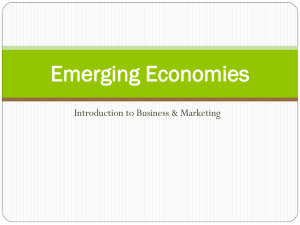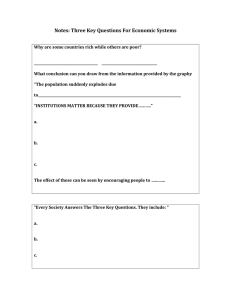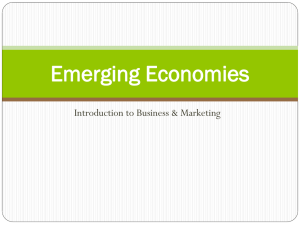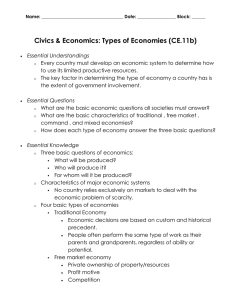World Economic Situation and Prospects 2015
advertisement
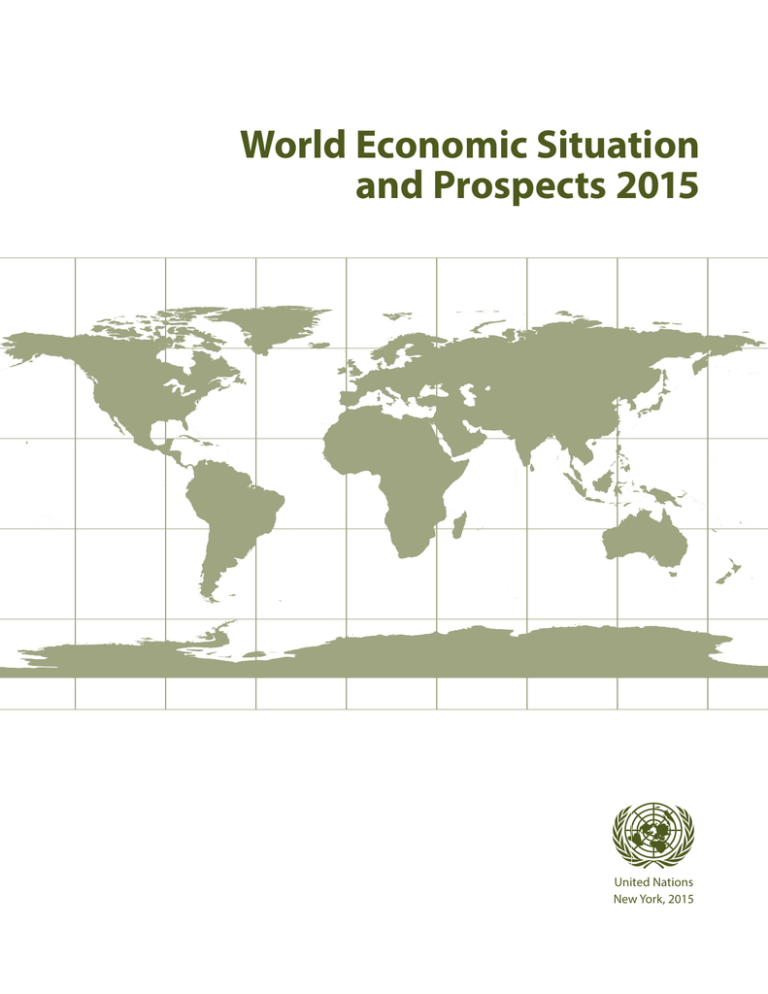
World Economic Situation and Prospects 2015 asdf United Nations New York, 2015 Executive summary Prospects for global macroeconomic development Global growth will improve slightly, but continue at only a moderate level The global economy continued to expand at only a moderate estimated pace of 2.6 per cent in 2014. Recovery was hampered by some new challenges, including a number of unexpected shocks, such as the heightened geopolitical conflicts in different parts of the world. Most economies have seen a shift in gross domestic product (GDP) growth to a noticeably lower path compared to pre-crisis levels, raising the spectre of longer-term mediocre economic growth. In the developed economies, although some improvements are forecast for 2015 and 2016, significant downside risks persist, especially in the euro area and Japan. Growth rates in developing countries and economies in transition have become more divergent during 2014, with a sharp deceleration in a number of large emerging economies, particularly in Latin America and the Commonwealth of Independent States (CIS). A number of these economies have encountered various country-specific challenges, including structural imbalances and geopolitical tensions. In the outlook period, the global economy is expected to expand at a slightly faster but still only moderate pace, with world gross product (WGP) projected to grow by 3.1 and 3.3 per cent in 2015 and 2016, respectively. Sluggish employment creation and weak wages remain major challenges A major weakness in the macroeconomic picture remains the employment situation, as GDP growth continued to be subdued and below potential in many parts of the world, and therefore did not create a sufficient number of productive jobs. In the developed economies, unemployment figures remain elevated in several countries, especially in the euro area, while wage levels continue to be affected by the financial crisis. In developing economies, despite slower employment growth, unemployment rates have remained relatively stable since 2013, partly owing to lower labour force growth, although informality and vulnerable employment are still highly prevalent. However, high unemployment levels persist in various countries, especially in Northern Africa and Western Asia as well as in some of the economies in transition in South-Eastern Europe. Benign global inflation encompasses deflation risks in the euro area and high inflation in some developing countries While the aggregate global inflation rate remains tame, this cannot mask a wide range of individual circumstances. Notably, inflation is elevated in about a dozen developing countries and economies in transition, while a growing number of developed economies vi World Economic Situation and Prospects 2015 in Europe are facing the risk of deflation. For the outlook period, global average inflation is projected to stay close to the level observed in the past two years, which was about 3 per cent. While aggregate average inflation for developed economies is expected to increase slightly until 2016, both developing economies and the economies in transition will register a decline in their aggregate inflation rates. International trade and finance Primary commodity prices trend lower, while trade growth will increase slightly International prices of primary commodities have been on a downward trend in the past two years, and no measurable upturn is projected for 2015–2016. International prices of oil declined sharply in the second half of 2014 and are projected to continue softening in 2015–2016, as the growth of demand for oil is expected to remain weaker than the increase in supply of oil. Non-oil commodity prices have also been on a decreasing trend, although they still remain high relative to their long-term trend of the past decades. Trade growth has been sluggish in the past few years, due mainly to the slow and uneven recovery in major developed countries and the moderate growth in developing countries. World trade is estimated to have expanded by 3.4 per cent in 2014, still well below pre-crisis trends. In the forecast period, trade growth is expected to pick up moderately along with improvement in global output, with the volume of world imports of goods and services projected to grow by 4.7 per cent in 2015 and 5.0 per cent in 2016. However, this projection is subject to various risks, including the possible disruptive effects on trade flows of any increase in geopolitical tensions in some subregions. Capital inflows to emerging economies have declined moderately, with a slight increase expected later in the forecast period Net private capital inflows to emerging economies have been on a moderate downturn since 2013, triggered by the tapering of the quantitative easing by the United States Federal Reserve, the deterioration in the growth prospects for these economies, and escalated geopolitical tensions. In 2014, net private inflows to this group of economies have declined, mainly because of capital flight from the Russian Federation amid a weakening economic situation and geopolitical strains. External borrowing costs continue to be relatively low for most emerging economies, but the risks for abrupt adjustments and increased volatility driven by changes in investor sentiment remain high. The outlook for capital inflows to emerging economies and developing countries remains moderately positive. Overall, net capital inflows are projected to stay at the same level in 2015 and slightly increase in 2016. But sudden shifts in investor sentiment due to geopolitical crises, the monetary policy change in the United States of America and a further divergence of the monetary policy stances of the major central banks might significantly affect portfolio flows. The divergence of monetary policy stances has already contributed to a significant strengthening of the dollar in the second half of 2014; a continuation of this trend could also underpin shifts in international trade patterns. Executive Summary Risks and uncertainties Monetary policy adjustments could create major macroeconomic instability The global economic outlook is subject to a number of risks and uncertainties. These include a deviation of monetary policy from the policy path built into the current baseline projection. Weaker- or stronger-than-expected macroeconomic data could underpin a delay or acceleration in the normalization of policy interest rates in the United States, with a multitude of broader implications. In the case of a slower rise in interest rates, possible effects are higher volatility in financial markets and systemic instability risks stemming from excessive asset price levels. By contrast, a quicker tightening in monetary policy would result in higher credit spreads, accompanied by an increase in volatility as well as significant repercussions for global financial markets. This could imply significant international spillover effects, especially for emerging economies, in the form of a fall in market liquidity and an increase in bond yields. The economic recovery in the euro area remains fragile A further risk is the fragile economic situation in the euro area. While monetary policy measures have led to a significant improvement in the sovereign debt crisis, the economic recovery remains precariously weak. The underlying growth momentum has decelerated to the point where an exogenous event could return the region to recession. The current tensions regarding Ukraine and resulting sanctions have already had a serious negative impact on activity and confidence. The weak state of the recovery is characterized by continued low levels of private investment, extremely high unemployment in many countries—which becomes more entrenched as the ranks of the long-term unemployed increase—and by dangerously low inflation, which carries the risk of turning into deflation. Emerging economies face a combination of domestic and external vulnerabilities Many large emerging economies continue to face a challenging macroeconomic environment, as weaknesses in their domestic economies interact with external financial vulnerabilities. At present, the main risk for many emerging economies arises from the potential for negative feedback loops between weak activity in the real sector, reversals of capital inflows, and a tightening of domestic financial conditions amid an expected rise in interest rates in the United States. Although the baseline forecast projects a moderate growth recovery in 2015 and 2016 for almost all emerging economies, including Brazil, India, Indonesia, Mexico, the Russian Federation, South Africa and Turkey, and only a slight moderation in China, there are significant risks of a further slowdown or a prolonged period of weak growth. A broad-based downturn in emerging economies, particularly a sharp slowdown in China, would not only weigh on growth in smaller developing countries and economies in transition, but could also derail the fragile recovery in developed countries, particularly in the struggling euro area. vii viii World Economic Situation and Prospects 2015 Geopolitical tensions constitute a major downside risk Geopolitical tensions remain a major downside risk for the economic outlook. In addition to the severe human toll, the crises in Iraq, Libya, the Syrian Arab Republic and Ukraine have already had pronounced economic impacts at the national and subregional levels, although the global economic effect has so far been relatively limited. A major reason for the limited global impact is that any actual or feared conflict-related decline in oil supplies was offset by oil production increases. Nevertheless, subregional economic weakness caused by conflict and sanctions could lead to a more pronounced slowdown for the world economy. In addition to geopolitical tensions, crises scenarios such as the current Ebola outbreak also imply a major degree of uncertainty for individual countries and subregions. Policy challenges Monetary policy in the United States faces the challenge of achieving a smooth normalization Monetary policy in the United States is charting its future path amid a host of challenges. The actual path of the policy interest rate will depend on a number of factors, especially the evolving macroeconomic picture regarding unemployment and inflation, as well as concerns about financial stability risks. At the same time, interest rates will be a major determinant, not just of the macroeconomic performance, but also the extent of financial stability risks and global spillovers. Policymakers must determine the optimal magnitude and timing of interest-rate changes while dealing with a difficult trade-off: to delay the policy tightening could create asset mispricing and financial stability risks; however, an unwarranted quick tightening could weaken the still unfledged recovery. Developed countries confront a difficult fiscal policy trade-off In the area of fiscal policy, developed countries find themselves in the difficult position of striking a balance between fiscal support for aggregate demand in the short run and ensuring fiscal sustainability in the long run. Many developing countries are facing the challenge of meeting the increasing demand for public finance for infrastructure, education and other services. Despite comparatively low public debt levels, developing countries also need to manage their external debt exposure, as refinancing external debt may prove to be costly in case of a sharp change in investor appetite towards emerging markets, a weakening of the exchange rate or higher levels of benchmark interest rates. Coherent labour market policies are needed to address employment problems Macroeconomic policies in many countries have been uncoordinated, creating only limited support for job creation. While expansionary monetary policies in developed economies may have averted otherwise larger falls in employment, the direct effects on employment growth are only limited. Monetary and fiscal policies should be combined with specific labour market policies. Policies should also be more amenable to the creation of businesses and jobs, for example, by streamlining administrative procedures. In many developing Executive Summary countries, in addition to greater economic diversification, continued efforts to expand formal employment and implement social protection programmes would also help in improving labour market conditions and supporting aggregate demand. Strengthening international policy coordination and cooperation is imperative In order to mitigate the myriad risks and meet the various challenges, it is imperative to strengthen international policy coordination and cooperation. In particular, macroeconomic policies worldwide should be aligned towards supporting robust and balanced growth, creating productive jobs, and maintaining economic and financial stability in the long run. Meanwhile, international policy coordination and cooperation is equally important for defusing geopolitical tensions and containing crises such as the Ebola pandemic. Other areas that make international and multilateral approaches indispensable include strengthening the resilience of the financial sector through further regulatory reforms, deepening cooperation on tax matters, reforming the governance of international financial institutions, expediting the WTO Doha Round negotiations, achieving concerted actions on combating climate change, delivering on the commitment of official development assistance to the least developed countries, and formulating and implementing a new post-2015 global development policy agenda, including the sustainable development goals. ix
